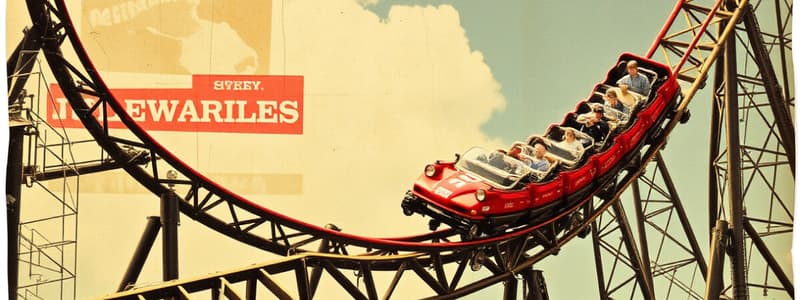Podcast
Questions and Answers
What does the traditional roller coaster use?
What does the traditional roller coaster use?
A lift chain
What's the significance of the stop height principle?
What's the significance of the stop height principle?
Galileo -- stop height = roller coasters can't go higher than the first hill
What happens with a positive G force?
What happens with a positive G force?
Blood feels heavier, can't pump blood to the brain, can blackout
What is a G-force?
What is a G-force?
Which G-force is an increased weight?
Which G-force is an increased weight?
Which G-force is a decreased weight?
Which G-force is a decreased weight?
What's the limit for positive G forces?
What's the limit for positive G forces?
What's the limit for negative G forces?
What's the limit for negative G forces?
When do you experience positive Gs?
When do you experience positive Gs?
When do you experience negative Gs?
When do you experience negative Gs?
What happens with a negative G force?
What happens with a negative G force?
What happens at 4 G?
What happens at 4 G?
What happens at 6 G?
What happens at 6 G?
What happens at 10 G?
What happens at 10 G?
What happens at 14 G?
What happens at 14 G?
How do roller coasters work?
How do roller coasters work?
How many G forces do we experience daily?
How many G forces do we experience daily?
How many G forces do stunt pilots experience?
How many G forces do stunt pilots experience?
How do stunt pilots not pass out?
How do stunt pilots not pass out?
What's the maximum G force for amusement parks?
What's the maximum G force for amusement parks?
Why do we enjoy roller coasters?
Why do we enjoy roller coasters?
What are the three sets of wheels on a roller coaster?
What are the three sets of wheels on a roller coaster?
What are running wheels?
What are running wheels?
What are up stop wheels?
What are up stop wheels?
What are friction wheels?
What are friction wheels?
What are different ways roller coasters are made now?
What are different ways roller coasters are made now?
How safe are roller coasters?
How safe are roller coasters?
Why is there wear and tear on roller coasters?
Why is there wear and tear on roller coasters?
Define friction.
Define friction.
Why doesn't all the potential energy of the coaster become kinetic energy?
Why doesn't all the potential energy of the coaster become kinetic energy?
What is the law of conservation energy?
What is the law of conservation energy?
Explain the energy conversions that take place on a roller coaster and explain how energy is conserved.
Explain the energy conversions that take place on a roller coaster and explain how energy is conserved.
Flashcards are hidden until you start studying
Study Notes
Roller Coaster Mechanics
- Traditional roller coasters utilize a lift chain to elevate the cars.
- The stop height principle, established by Galileo, dictates roller coasters cannot exceed the height of the first hill.
G-Forces in Roller Coasters
- Positive G-force creates a sensation of increased weight; blood feels heavier, potentially causing blackouts due to reduced blood flow to the brain.
- Negative G-force results in a sense of decreased weight; blood feels lighter, which can lead to a "red out" effect due to excess blood flow to the brain.
G-Force Limits and Experience
- Maximum tolerable positive G-force is 4 G, leading to a fourfold increase in body weight.
- Maximum tolerable negative G-force is 1/2 G.
- Positive G-forces are primarily experienced at the bottom of hills and during loops.
- Negative G-forces occur at the peaks of hills.
Effects and Risks of G-Forces
- At 6 G, physical damage like nosebleeds can occur.
- At 10 G, individuals may lose consciousness.
- At 14 G, there is a risk of fatal consequences.
Energy Transformations
- Roller coasters convert potential energy into kinetic energy as the lift chain raises the cars, with gravity taking over once the drop begins.
- Daily life generally involves experiencing around 1 G of force; stunt pilots may endure 8-10 G due to maneuvering.
- Stunt pilots prevent loss of consciousness by tightening their muscles.
Roller Coaster Safety and Construction
- Amusement parks maintain a maximum of 4 positive Gs for safety standards.
- Roller coasters are routinely inspected for safety features, ensuring regular maintenance to manage wear and tear from Newton's Third Law.
- Modern roller coasters may utilize electromagnet systems for acceleration or compressed air.
Wheel Systems on Roller Coasters
- Running wheels are positioned above track rails to support and guide cars.
- Up stop wheels, mounted beneath tracks, prevent cars from derailing when upside down.
- Friction wheels, located inside the track, prevent sideways derailment.
Physics of Motion and Energy Conservation
- Friction is the force opposing motion between two surfaces, impacting energy transformation.
- Not all potential energy converts to kinetic energy; some is lost as thermal and sound energy due to friction.
- The law of conservation of energy states energy cannot be created or destroyed, maintaining the total energy within the system constant.
Studying That Suits You
Use AI to generate personalized quizzes and flashcards to suit your learning preferences.




